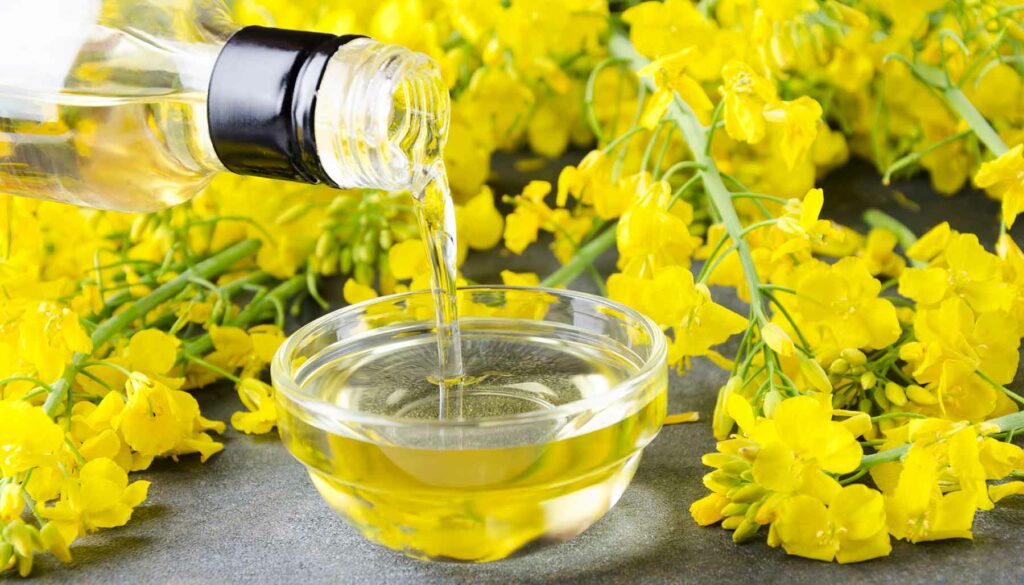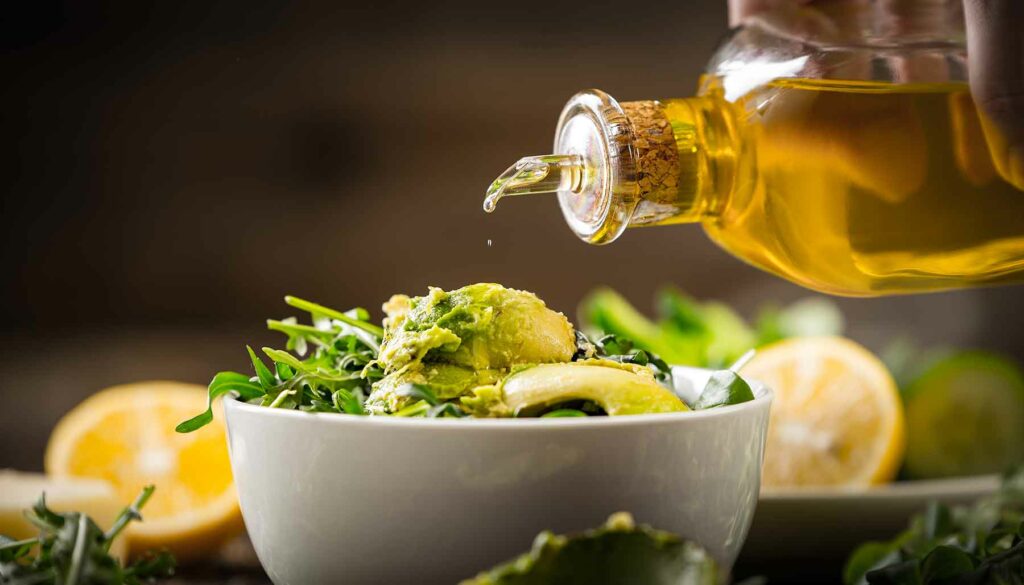When it comes to cooking oils, there are a ton of options out there. Just take a stroll down the aisle at your grocery store, and you’ll see exactly what I mean.
With such a wide variety of options, it can often be confusing or overwhelming to choose which one to use. There’s vegetable oil and coconut oil, plus a handful of different olive oils. Did you know that avocado oil is a thing? What in the world is safflower oil used for?

There’s more to choosing a cooking oil than just taste – although they do all have different tastes! All those different oils have different applications, and they can’t all be used the same way. They have their own distinct smoke points, shelf lives, and nutritional values. Some might be best when cooking at a high temperature, while others are best drizzled as a finishing oil. Not all oils make for a good homemade dressing, and likewise, not all of them are the right pick when baking.
So, how in the world do you know which cooking oil to choose for a given recipe? Well, that’s where this list comes in. We’re going to go over the basics of all those cooking oils! It should give you a better understanding of the different kinds of cooking oils and which applications each oil is best suited for.
First, let’s go over a few basics.
What Is a Smoke Point?
Before we can dip into the actual oils, we have to talk about what a smoke point is. This is the temperature where the oil starts to burn. It is no longer shimmering and is sending up some smoke signals. The oil’s nutrients will start to degrade, and it will give your food a burnt flavor. This is definitely not what you want when cooking.
This is why it is so important to pay attention to a cooking oil’s smoke point. Choose the wrong one for high-temp cooking, and it could have disastrous effects on your dinner.
Unrefined oils are usually more flavorful because they haven’t had their minerals and other compounds removed. They retain their natural flavors and colors. Those compounds don’t play well with heat, though. These unprocessed, cold-pressed, or “virgin” oils are best suited for low-temperature cooking, making dressings, or simply drizzled as a finishing oil.
For the most part, oils with a higher smoke point tend to have a neutral flavor. That’s because they have been refined to remove those compounds. It makes them more shelf-stable, and it bumps that smoke point higher. While these obviously don’t boast all the same health benefits as their unprocessed counterparts, they are necessary for higher temperatures, like searing and frying.
Properly Storing Cooking Oils

No matter how shelf-stable an oil is, light, heat, and air are sworn enemies to its lasting power. It will go bad quickly without paying attention to how you store it. Paying attention to these will have a huge impact on the shelf life, freshness, flavor, and quality of your oils:
Keep it cool: Cooking oils need to stay cool – even those with high smoke points. Being exposed to heat can lead to rapid rancidity. Ideally, you want to keep your oil around 60 degrees Fahrenheit or under. You can refrigerate many oils, but that means you need extra time and patience to heat the oil every time you use it, which is no bueno for the ones you use daily. The fridge is an excellent place for those flavorful unrefined oils, though.
The darker, the better: Just like with heat, the light will also quickly degrade cooking oil. Sorry, all those decorative bottles showcasing your oils are doing terrible things to the contents inside. You should be storing your oils in dark glass bottles that let in little to no light. If you purchased oil in a clear bottle, consider wrapping them in aluminum foil to block out the light.
Avoid air: All that air will also degrade oils. Too much exposure will leave you with a bland, flavorless oil. Glass bottles with tightly-closed caps are a must.
Okay, Bring on the Oils!
Let’s take a look at some of the cooking oils available. We’ll talk about flavor, smoke point, and what they’re best used for.
Olive Oil

Regular ol’ olive oil is a kitchen staple for many people. It is made from olives and contains antioxidants and monounsaturated fats (versus unhealthy saturated and trans fats). This oil is refined, making it more shelf-stable and suitable for higher heat. It also has a relatively neutral flavor and aroma. Many cooks use olive oil as a general-purpose cooking oil, and it works for a wide variety of cooking and baking.
Smoke Point: 465 degrees F
Extra Virgin Olive Oil
Extra virgin olive oil (EVOO) is also made from olives, but it deserves its own spot on this list. That’s because it is unrefined and cold-pressed, meaning it is never extracted using heat or chemicals. While this means it has a much lower smoke point than regular olive oil, it also means it is higher in antioxidants and other nutrients. EVOO boasts much more flavor, making it a prime choice for dipping, dressing, and drizzling. It can also handle low-temp sauteing.
Smoke Point: 350 degrees F
Coconut Oil

In recent years, coconut oil has become quite the star. It has transcended the food world and become a key ingredient in many natural beauty remedies, from hair deep conditioner to makeup remover. But first and foremost, it’s a cooking oil! Extracted from dried coconut meat, you can probably guess that this oil has a warm, sweet taste and aroma – just like the coconuts it was made from. It has a lower heat tolerance, so this one is best for baked goods, smoothies, and other low- or no-heat uses. Unlike other oils with a lower smoke point, it’s not really a good choice for dressings, and you can’t use it for dips or drizzles. That’s because coconut oil is usually solid at room temperature.
Smoke Point: 350 degrees F
Vegetable OIl
Vegetable oil often gets a bad rap for being unhealthy. That’s because it’s not, really, and it’s highly processed. Hey, it has its perks, though. All that processing makes this one shelf-stable and good for high temperatures. When it comes to stuff like deep-frying, you know what to do. However, when it comes to other applications, like regular sauteing or baking, it’s best to stick with healthier options.
Smoke Point: 450 degrees F
Canola Oil

Canola oil is kind of similar to vegetable oil but gets a slightly better rap. It has less saturated fat and provides the omega-3 fatty acid alpha-linolenic acid (aka ALA). Because it is processed, it does pretty well with higher heat. That means it provides a wide range of uses, from sauteing to baking to frying. However, it has no business in dressings or dips since it doesn’t really provide anything flavor-wise. It also doesn’t really do much for you in terms of other beneficial nutrients.
Smoke Point: 400 degrees F
Safflower Oil
Safflower oil is another “vegetable oil” that isn’t vegetable oil. Refined, it behaves and tastes a lot like vegetable oil, but it’s better for you. It’s still pretty neutral with a high smoke point, but it is also rich in unsaturated fats. While it is high in vitamin E, it isn’t really a good source of other nutrients – but that’s mostly the case when it comes to cooking oils. Refined safflower oil has a higher heat tolerance than many other cooking oils, making it perfect for high-heat sauteing and frying.
Smoke Point: unrefined, 225 degrees F; refined, 510 degrees F
Avocado Oil

We already know that avocados are good for guacamole, avocado toast, and even grilled avocado and mango salad for the next cookout. But, avocado is also used to make avocado oil! Instead of being made from a seed like many other cooking oils, this one is made from that creamy green goodness. It’s a heart-healthy option with plenty of avocado-forward taste. This is one of the rare cases where a cooking oil has both a high smoke point and lots of flavor. It’s pretty versatile. Use it to make dressings and dips, or take advantage of it for high-temperature cooking.
Smoke Point: unrefined, 480 degrees F; refined, 520 degrees F
Sesame Oil
I actually like to use sesame oil quite a bit. It really adds a lot, thanks to its distinctly rich, nutty flavor. This is definitely not a neutral oil choice. Sesame oil isn’t one that you reach for randomly for any ol’ recipe, but it’s the perfect choice in certain applications. It is often used in Asian recipes, but I like to add a touch in other foods, too, like when I’m making sauteed greens. Unrefined sesame oil doesn’t have a high smoke point, but refined sesame oil does. It’s tasty enough to drizzle on noodles or whisk into a dressing, but I like to throw a little in stir fry, too.
Smoke Point: unrefined, 350 degrees F; refined, 450 degrees F













